Are you a Quiet Speculation member?
If not, now is a perfect time to join up! Our powerful tools, breaking-news analysis, and exclusive Discord channel will make sure you stay up to date and ahead of the curve.
When Wizards banned Gitaxian Probe on Monday, many players reached out to me to express their condolences and ask where Temur Delver goes from here. Probe was an integral part of my Monkey Grow deck, and starting games by paying 2 life for the sorcery was some of the most fun I ever had playing Magic. I will sorely miss the cantrip, but I also don't think Temur Delver is going anywhere.

This article proposes a new build of Temur Delver that uses Traverse the Ulvenwald to present pilots with tools to handle any situation.
[wp_ad_camp_1]
Thoughts on the Ban
Before we jump into the deck discussion, I feel compelled to briefly discuss Wizards' January 9th announcement.
First Impressions
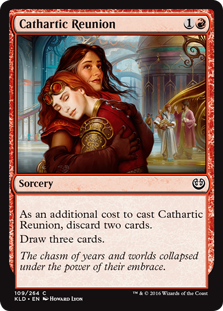 The Grave-Troll ban I'm totally on-board with, as I wrote two weeks ago. Dredge polarized Modern to a frightening extent and greatly lowered the format's diversity. That said, I wish Wizards had made any of these effects explicit in their inexcusably curt explanation of changes. As usual, transparency proves the company's weakest suit. Too bad we can't "Probe" those guys!
The Grave-Troll ban I'm totally on-board with, as I wrote two weeks ago. Dredge polarized Modern to a frightening extent and greatly lowered the format's diversity. That said, I wish Wizards had made any of these effects explicit in their inexcusably curt explanation of changes. As usual, transparency proves the company's weakest suit. Too bad we can't "Probe" those guys!
The Gitaxian Probe ban took me by surprise. Since I'm a firm believer in Modern's ability to police itself, I prefer conservative management of the banlist and baby-step movements. In my opinion, the Grave-Troll ban alone would have decreased Infect's metagame share by giving midrange decks some room to breathe.
I still think the Probe ban was an elegant way of slowing down the format, since it affects three aggro-combo decks at once. But the Dredge ban, combined with the printing of [tippy title="Fatal Push" width="330" height="330"]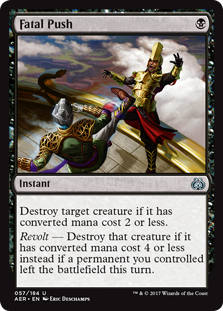 [/tippy], may have been enough. I feel Wizards implemented this change too quickly. The ban's obvious splash damage, which fundamentally alters certain Delver decks (ahem) and renders Storm unplayable, further calls Wizards' haste into question.
[/tippy], may have been enough. I feel Wizards implemented this change too quickly. The ban's obvious splash damage, which fundamentally alters certain Delver decks (ahem) and renders Storm unplayable, further calls Wizards' haste into question.
Delving Deeper
It appears from the announcement that aggro-combo decks having access to free information is just not something Wizards wants to be a feature of the format. That's fine with me, so long as Wizards tells us this while acknowledging that Probe didn't violate any of the format's guidelines, at least as overtly as some other banned cards.
At the same time, I probably trust Wizards' management of the list more than most. I've supported even their more controversial decisions since the Nacatl ban, which was also a little heavy-handed  for my taste (in that scenario, banning Punishing Fire would likely have been enough to bring x/2 creatures back into the format; banning Wild Nacatl was overkill). With all said and done, though, Wizards has way more data on hand about how games actually play out, and what turn they end on, than we could ever dream of. If they say Probe contributed to an unacceptable number of turn-three kills, I believe them.
for my taste (in that scenario, banning Punishing Fire would likely have been enough to bring x/2 creatures back into the format; banning Wild Nacatl was overkill). With all said and done, though, Wizards has way more data on hand about how games actually play out, and what turn they end on, than we could ever dream of. If they say Probe contributed to an unacceptable number of turn-three kills, I believe them.
Some good may also come of the Probe ban. The now-nerfed UR Prowess is the only deck that Preordain seems scary in, and if blue continues posting miserable numbers this cycle, I'd be surprised if the super-Sleight of Hand continued to rot on the banlist beside the likes of Skullclamp and Treasure Cruise.
Temur Delver Without Probe
Gitaxian Probe held a crucial post in Temur Delver. Without it, the deck needs a complete overhaul. To develop a new build, I considered what Probe did for the deck, and whether to add cards that fulfill similar roles or ones that enabled additional angles of attack.
But Why Play Temur Delver At All?
Grixis Delver had largely transitioned away from running Probe at all by the time it was banned, so I think this question bears revisiting.
Delver strategies occupy a unique space in the Modern metagame, which is defined by the rock-paper-scissors super-archetype triangle of linear aggro (Infect, Affinity), big mana (Tron, Eldrazi), and aggro-control (especially midrange, i.e. Jund, Grixis). Tempo decks are aggro-control decks like midrange, and therefore enjoy favorable matchups against linear aggro. But due to the order in which they deploy threats and disruption, they post favorable matchups against Tron and other big mana strategies, while midrange decks do not.
The reasons to play Temur Delver over Grixis Delver have always been Disrupting Shoal, Blood Moon, and Tarmogoyf. Thanks to these cards, Temur in particular boasts the strongest big mana matchup of all Delver decks. Temur also applies pressure quickly enough that linear aggro-combo has a very difficult time beating it.
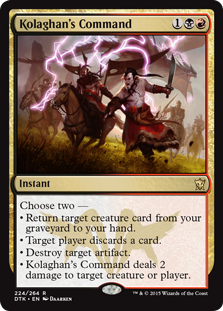 Temur's weakness is Jund and other midrange strategies, which punish it for lacking the tools to keep up with their grinding. Grixis Delver has access to these tools (Kolaghan's Command, Snapcaster Mage, Tasigur).
Temur's weakness is Jund and other midrange strategies, which punish it for lacking the tools to keep up with their grinding. Grixis Delver has access to these tools (Kolaghan's Command, Snapcaster Mage, Tasigur).
Losing Gitaxian Probe means adding other sorceries for Tarmogoyf, and I've settled on Traverse the Ulvenwald. This card is the new primary reason to play Temur over Grixis, as it gives Temur tools to beat midrange while retaining its favorable matchups against linear aggro and big mana.
The metagame has been hostile to graveyard strategies lately, but with Dredge taking a hit, I expect Traverse to be safe again and Temur Delver to become well-positioned in Modern. This Probeless build also resists graveyard hate better than its predecessors.
Probe's Roles in Temur
Wizards said of Gitaxian Probe, "Ultimately, the card did too much for too little cost." The statement couldn't hold truer for Temur Delver. In this deck, Probe achieved the following for zero mana:
- Allowed us to run fewer lands via the Turbo Xerox Rule.
- Ensured Tarmogoyf would resist Lightning Bolt on turn two.
- Filled the graveyard for Hooting Mandrills.
- Gave us an easy Snapcaster target.
- Turned Serum Visions into Preordain.
- Pitched to Disrupting Shoal.
- Transformed Delver of Secrets.
- Served as a spell to transform Ravager of the Fells back into Huntmaster of the Fells.
- Trivialized achieving delirium for Traverse the Ulvenwald.
- Upped our instant/sorcery count in the graveyard for Bedlam Reveler.
- Provided perfect information at any stage in the game with which to maximally manage limited mana sources; sequence conditional countermagic; know what to dig for while cantripping; choose whether to focus on resolving Blood Moon on turn three; go all-in with Simic Charm for damage or with threats without fearing a board wipe; and more.
Obviously, there's no true substitute for a card that versatile. A couple questions I asked myself after the ban were how many cards I wanted to run that played similar roles to Probe, how much of the deck's core I was comfortable scrapping, and whether to introduce new proactive plans that addressed the deck's previous failings. I came up with this list:
Temur Delver, by Jordan Boisvert
Additions
The Probe axe marks four slots to fill right off the bat, and accommodating for Probe's absence in other ways necessitates even more tweaks. Here's what I added to Temur Delver.
4x Traverse the Ulvenwald
For one mana, Traverse finds us a specific card, instead of whatever's on top of the deck. I have always liked Traverse in this deck, as it combines with Bedlam Reveler to give us a great plan against midrange.
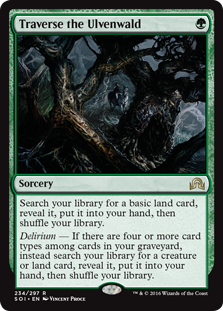 The ceiling on Traverse is very high, especially in sideboarded games. But its floor is still pretty reasonable. At its absolute worst, Traverse is an Evolving Wilds that flips Delver, grows Goyf, pays for Mandrills, buffs Reveler, helps transform Ravager of the Fells, shuffles away a sour card revealed by Bauble, and can be flashed back with Snapcaster. This wealth of possible roles makes Traverse appealing as a Probe replacement.
The ceiling on Traverse is very high, especially in sideboarded games. But its floor is still pretty reasonable. At its absolute worst, Traverse is an Evolving Wilds that flips Delver, grows Goyf, pays for Mandrills, buffs Reveler, helps transform Ravager of the Fells, shuffles away a sour card revealed by Bauble, and can be flashed back with Snapcaster. This wealth of possible roles makes Traverse appealing as a Probe replacement.
To my surprise, I didn't encounter much tension between Traverse the Ulvenwald and Hooting Mandrills. While playing those two cards together with Bedlam Reveler tested nightmarishly, omitting the Reveler makes their apparent anti-synergy more than manageable.
Temur Delver wants to land a hard-to-remove threat, protect it with countermagic while disrupting an opponent's plays, and win. A delirium-enabled Traverse can find our first threat (generally Tarmogoyf, but sometimes Mandrills if we'll need mana for countermagic) or add to the clock. The midrange decks that can remove our threats consistently fill the graveyard right back up for delirium. Those that can't are likely to lose to Denial and Leak while we turn the Ape sideways. It's also frequently correct to burn Traverses early and find basics, which gives us more sequencing options in the mid-game.
2x Mishra's Bauble
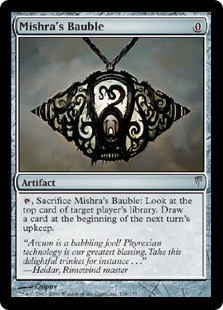 Mishra's Bauble is the closest Probe analog left in Modern. It provides information (albeit much less) and a card in the graveyard, while cantripping and at no cost. I have experimented with Bauble in Temur Delver shells before, and the card impressed me. But we could never justify cutting Monkey Grow's more impactful or versatile cards for Bauble until now, when we don't have a choice.
Mishra's Bauble is the closest Probe analog left in Modern. It provides information (albeit much less) and a card in the graveyard, while cantripping and at no cost. I have experimented with Bauble in Temur Delver shells before, and the card impressed me. But we could never justify cutting Monkey Grow's more impactful or versatile cards for Bauble until now, when we don't have a choice.
Besides helping with delirium, Bauble makes it trivial to grow Tarmogoyf larger than 4/5. I anticipate this benefit to be of great value in the new metagame. Tasigur, the Golden Fang and Reality Smasher are sure to rear their hideous heads, and having Lhurgoyfs that out-body these creatures (eight of them if you count Traverse) should work wonders against the decks that play them.
We never want to see multiple Baubles at a time, and often only want to hit one per game. Thus I don't think it's correct to run more than two.
One-of Additions
- Thought Scour #4: The most obvious addition to Temur Delver post-ban, a fourth Scour helps us enact our gameplan more often, and fills some of the roles left empty by Probe.
- Snapcaster Mage #2: Probe gone, Push coming—Modern is sure to slow down. We're adding an 18th land in one Probe slot anyway. A second Snapcaster guarantees we always have one left in the deck to search out with Traverse.
- Dismember: Not running Probes leaves us with more life than I generally like to have. We take little enough damage now that I'm comfortable playing this powerful spell in the main over the second Vapor Snag.
- Wooded Foothills #2: Without Probe we should add an 18th land to the deck. I prefer Foothills to Spirebluff Canal—the fetch offers synergies with Bauble, Goyf, Serum, Moon, and delirium, and we have more life to spare without Probe.
Omissions
This new build is also missing some usual suspects. Let's go over some major omissions and the reason I didn't include them.
Disrupting Shoal
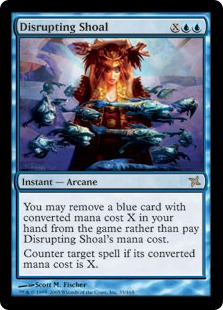 We touched above on how Traverse compensates for Disrupting Shoal's absence, especially in a grindier metagame. The linear decks Shoal tends to crush are also sure to take a dive with Probe gone from their repertoire. Running Traverse, Bauble, Dismember, and another land makes it difficult to fit in enough blue spells for Shoal to shine. Finally, the information Probe would grant us at the start of a game greatly improved Shoal's utility, since we could sequence the counterspell perfectly. Blind-Shoaling is much less attractive.
We touched above on how Traverse compensates for Disrupting Shoal's absence, especially in a grindier metagame. The linear decks Shoal tends to crush are also sure to take a dive with Probe gone from their repertoire. Running Traverse, Bauble, Dismember, and another land makes it difficult to fit in enough blue spells for Shoal to shine. Finally, the information Probe would grant us at the start of a game greatly improved Shoal's utility, since we could sequence the counterspell perfectly. Blind-Shoaling is much less attractive.
I can see Shoal returning if decks like Bogles and Death's Shadow Zoo make a comeback, but I'm starting off without them in an expected metagame of Abzan, Grixis, and Tron.
Spell Snare
Spell Snare is a card I have advocated for in grindy metagames, especially over Disrupting Shoal. There's also some precedent for its viability—Joshua Yang Zing payed a Snare over one of two axed Shoals in his Top 8 list from GP Singapore.
The main reason I've omitted Snare from this list is space. I found myself wanting to keep my counterspells against interactive decks like Jeskai, but would have to remove Spell Snare when bringing in Bedlam Reveler, since it's too conditional to spend easily before discarding and drawing three. That tension leaves precious few cards in the maindeck that I feel like cutting for a pair of Snares, which I would frequently switch out anyway. At least for now, I'd rather run the classic 3/3 Leak/Denial split and fill out the other interaction slots with removal.
Simic Charm
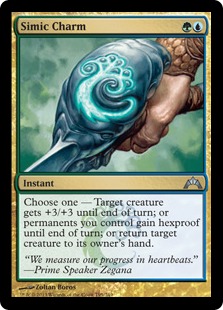 Charm has also been a staple of the deck since its creation. The matchups Simic Charm excelled in were the midrange ones, where it could push through damage with Mandrills or Goyf despite a blocking behemoth on the other end. Hexproof mode also protects threats from Abrupt Decay and other removal spells, while bounce mode worked best versus linear pump decks.
Charm has also been a staple of the deck since its creation. The matchups Simic Charm excelled in were the midrange ones, where it could push through damage with Mandrills or Goyf despite a blocking behemoth on the other end. Hexproof mode also protects threats from Abrupt Decay and other removal spells, while bounce mode worked best versus linear pump decks.
I prefer to avoid Simic Charm when I'm on Bedlam Reveler, since the midrange matchup becomes much easier with that plan and Snag is simply more efficient. In this particular build, Dismember takes the place of that second Snag anyway.
Sideboard
I'm with Ryan Overturf when it comes to purging the sideboard of graveyard hate until and unless Dredge continues to pose problems. The sideboard I propose here is full of Monkey Grow staples, with an exciting new development: Huntmaster of the Fells and Bedlam Reveler, to date, have been exclusive plans, for reasons of space. With Traverse the Ulvenwald in the mainboard we have room for both, giving us the tools to beat up on go-wide aggro decks, midrange strategies, and graveyard hosers alike.
Moon, Revelry, Grudge, Pyroclasm
These cards are always present in Monkey Grow sideboards. During Dredge's worn-out stay in Modern, we ran Anger of the Gods over Pyroclasm. But in most matchups, including Affinity, Merfolk, Burn, Tokens, and Abzan, the more efficient spell is always superior. Anger is about as strong as Pyroclasm against Coco/Chord decks, contrary to popular belief. I don't see a reason to stay on the clunkier card with Dredge likely to fade away.
Huntmaster of the Fells
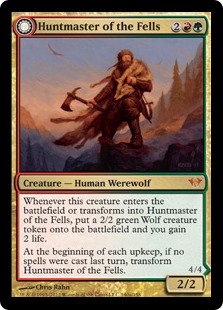 Huntmaster of the Fells walks away with games against Merfolk, Affinity, Coco/Chord, Tokens, Burn, and many other aggro decks. He also provides a way to win through Ensnaring Bridge, and joins Delver of Secrets in totally ignoring Rest in Peace effects. Packing Huntmaster in the side gives us a respectable plan against bigger aggro decks and makes it difficult for opponents to hate us out. That he further complicates the midrange matchup for BGx opponents is gravy. The four-Huntmaster board plan also becomes more reliable on a functional 22 lands.
Huntmaster of the Fells walks away with games against Merfolk, Affinity, Coco/Chord, Tokens, Burn, and many other aggro decks. He also provides a way to win through Ensnaring Bridge, and joins Delver of Secrets in totally ignoring Rest in Peace effects. Packing Huntmaster in the side gives us a respectable plan against bigger aggro decks and makes it difficult for opponents to hate us out. That he further complicates the midrange matchup for BGx opponents is gravy. The four-Huntmaster board plan also becomes more reliable on a functional 22 lands.
Bedlam Reveler
Bedlam Reveler ensures attrition wars are rarely won against Temur Delver, especially when it's drawing into Huntmasters. Early game we apply pressure and threaten Blood Moon, and then follow up by tutoring for a string of 3/4 draw-threes in the mid-game. This gives us the shot in the arm we needed against Jund and other midrange strategies that have traditionally oppressed Modern's blue Tarmogoyf decks.
Engineered Explosives
I've never played Engineered Explosives in Monkey Grow before, but I think it's quite powerful these days. Aside from providing another out to Chalice of the Void, Explosives can wipe out a swarm of Lingering Souls tokens or remove problematic permanents like Liliana of the Veil—all while pumping Tarmogoyf.
Papa's Got a Brand New Monkey
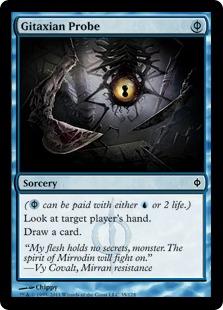 This particular build of Monkey Grow featuring Traverse loses some speed, to be sure, and the information that allowed it to abuse Disrupting Shoal. But I'm optimistic about the deck's chances, no matter if the format leans towards [tippy title="Fatal Push" width="330" height="330"]
This particular build of Monkey Grow featuring Traverse loses some speed, to be sure, and the information that allowed it to abuse Disrupting Shoal. But I'm optimistic about the deck's chances, no matter if the format leans towards [tippy title="Fatal Push" width="330" height="330"] [/tippy], Oblivion Stone, or Mutagenic Growth. Even with the loss of Gitaxian Probe, the stage might finally be set for Delver of Secrets to demonstrate its worth in the format known for Lightning Bolt and Abrupt Decay.
[/tippy], Oblivion Stone, or Mutagenic Growth. Even with the loss of Gitaxian Probe, the stage might finally be set for Delver of Secrets to demonstrate its worth in the format known for Lightning Bolt and Abrupt Decay.


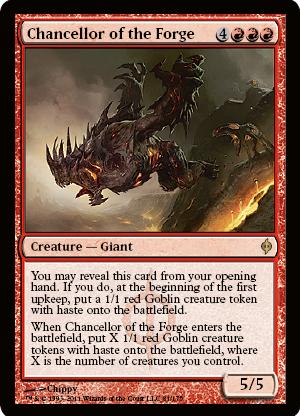



Thanks for the article, I knew this one was coming as soon as I saw the probe ban. I’m glad to see traverse the ulvenwald getting some more love, but I’m sad to see disrupting shoal go. How do you think counter-cat will weather the probe banning? seems like a harder hit to them than most delver decks.
Counter-Cat could only run a pair of Probes because of the damage it took from its manabase. Losing Probe from the deck doesn’t hurt that badly, but the metagame slowing down and Push coming to town does. CC lacks access to tools like Reveler that just hammer midrange. Mutagenic Growth also night become a less reliable answer to 1CMC removal.
Thanks for the article Jordan :). I’ll continue to follow nexus’ coverage of Delver decks with great enthusiasm. I really like the look of this build, and I hope it does well for you! Traverse looks very strong in this deck, and that sideboard just -looks- fun. I am very curious about the concept of life management in this deck and shell, though. You made the comment about not being comfortable losing so little life to yourself that you were ok running a Dismember. Are you just leveraging a balance of resources here? Does Temur really need the Dismember when you’ve noted in the past that Spite of Mogis can usually do just as well, especially with Thought Scour in the mix?
Leveraging resources for sure. Spite is not really a main-deckable card, although I have tried it in a few shells. Dismember is much stronger because it interacts at instant speed and is less conditional.
But Spite has a better time killing Goyfs! Dealing with a 6/7 across the table has been my biggest obstacle in this new build. I’m starting by trying a second EE in the side and replacing Snag with Simic.
Since you expect a metagame of Abzan, Grixis, and Tron, is this really the time to work so hard for goyf? All 3 will be leveraging Fatal Push so I can’t imagine why you’d play a goyf centered deck. [For the record, Tron has no reason to go white in dredge-free world; path befones push, and Blessed Alliance becomes Collective Brutality.]
If that’s the meta, isn’t this a bad time for the new monkey grow given Aether Revolt’s new removal? What deck preys on those three instead?
It’s more that we’re working hard for Traverse, and Goyf happens to get really big as a result. As noted in my comment above, I’m still shopping around ways to deal with opposing Goyfs. Looks like a pair of EEs in the side is the place to start.
It’s true that Goyf is worse in a world full of Pushes, but Mandrills arguably gets better, and so do Bedlam Reveler, Huntmaster, and Blood Moon. The Reveler plan is great against the BGx shells and Monkey Grow has always been good against Tron. We’ll see if Push changes that.